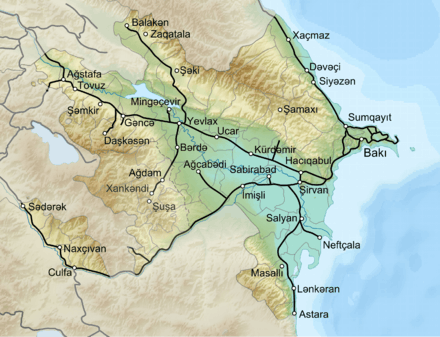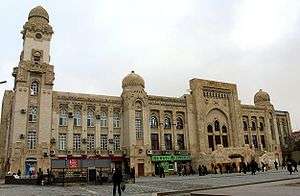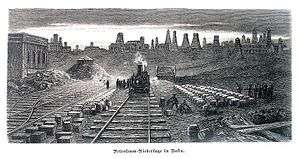Rail transport in Azerbaijan
Rail transport in Azerbaijan is operated by the national state-owned railway company Azerbaijan Railways (Azerbaijani: Azərbaycanda Dəmiryolu). The railway network consists of 2,918 km (1,813 mi), its gauge is 1,520 mm (4 ft 11 27⁄32 in) (Russian broad gauge), 815 km (506 mi) are double track and 1,272 km (790 mi) are electrified at 3 kV (3,000 V) DC.[1]
| Azerbaijan | |
|---|---|
 Azerbaijan railway network | |
| Operation | |
| National railway | Azərbaycanda Dəmiryolu |
| System length | |
| Total | 2,932 kilometres (1,822 mi) |
| Double track | 815 kilometres (506 mi) |
| Electrified | 1,272 kilometres (790 mi) |
| Freight only | 810 kilometres (500 mi) |
| High-speed | 0 kilometres (0 mi) |
| Track gauge | |
| Main | 1,520 mm (4 ft 11 27⁄32 in) |
| Electrification | |
| 25 kV 50 Hz | Main network |
Azerbaijan's location and infrastructure have contributed to the vibrant transport sector of the country. Railways take up 16.7% of Azerbaijan's freight traffic flows. Throughout 2005-2009, a massive railway modernisation programme was initiated.[2] Expansions costing $795 million were announced in 2012 to respond to the growing demand for rail transport in the country.[3] Also Stadler Rail and local partner International Railway Distribution LLC announced the formation of a 51:49 joint venture on July 17, 2014.[4]
History
Russian Imperial Railways 1878-1917
The first railway line in Azerbaijan then belonging to the Russian Empire was laid in 1878 and was opened in 1880 within the suburban range of Baku, which led from Sabunçu to Suraxanı, today situated within the city of Baku. The track width corresponded to the Russian 1,520 mm (4 ft 11 27⁄32 in) gauge.
The first long-distance railway line was opened in 1883, which led from Baku to Tbilisi in Georgia.
In 1900 railway lines were opened which connected Baku via Biləcəri with Derbent and Petrovsk (Makhachkala) in Dagestan and thus connected Azerbaijan with the rest of the Russian Empire (and later the Soviet Union).
In 1908 with extension of the railway line from Ararat in Armenia to Şərur and Julfa in the Nakhchivan exclave of Azerbaijan, this part of Azerbaijan was connected with Armenia.
Thus the development of the Azerbaijani Railway was for the time being considered final.
Soviet Railways 1917-1991
After the collapse of the Russian Empire and the Russian Revolution the country was transformed into the Soviet Union and the Russian Imperial Railways into the Soviet Railways.
Due to the availability of electricity from the vast water power sources of Azerbaijan, the very early electrification of the railway lines of Azerbaijan began. In 1926 with the electrification with 1,2 kV (1,200 V) direct current of the railway line between Baku and Sabunçu, it became the first electrically operated railway line of the Soviet Union. Later electrifications took place with 3 kV (3,000 V) direct current.
In 1924 the railway line was extended southwards to Ələt and Neftçala.
In 1941 the railway line was extended from Horadiz and Mincivan through Armenia including a railway line extension to Kapan, to Julfa in the Nakhchivan exclave of Azerbaijan. Thus the Nakhchivan exclave of Azerbaijan was finally connected with Azerbaijan proper.
In 1941 the railway line was also extended southwards to Astara, Azerbaijan at the southern border with Iran.
In 1944 the railway line was extended to Kətəlparaq, Ağdam and Stepanakert (Xankəndi).
Until 1991 the railway traffic was operated in Azerbaijan by the Soviet Railway under supervision of the Soviet Traffic Ministry. The Azerbaijani branch of the Soviet Railways was divided into three departments of Baku, Gəncə and Nakhchivan City.

Azerbaijan Railways (Azərbaycan Dəmir Yolları) 1991-
With the independence of the Republic of Azerbaijan in 1991, the Azerbaijan State Railways (Azərbaycan Dövlət Dəmir Yolları) was formed the same year.
Azerbaijan Railways CJSC
Azerbaijan Railways Closed Joint Stock Company was established by a reorganisation of the Azerbaijan State Railway in 2009. The Company includes Transportation Processes Management Union, Passenger Transportation Production Union, Locomotive Production Union, Carriage Service Production Union, Road Production Union, Power Supply Production Union, Indication and Communication Production Union, Militarised Enforcement Organization, Nakchivan Department and other enterprises.
The international network serves Russia (Baku-Moscow, Baku- Saint-Petersburg, Baku-Rostow, Baku-Tumen, Baku- Mahachkala), Ukraine (Babu-Kiev, Baku-Xorkov), Georgia (Baku-Tbilisi). Domestic routes are Baku-Kocherli-Balaken, Baku-Astara-Horadiz, Baku-Kazakh- Boyuk Kesik, Baku-Agstafa, Baku-Gandja, Baku-Mingechevir, Baku-Astara routes.[5][6]
Network
So far 2,932 km of rail tracks including 2,117 km of carrier service lines, 810 km of industrial lines have been laid in Azerbaijan. In 1988, during the Nagorno-Karabakh conflict, territories of Azerbaijan with 240 km of rail tracks were occupied by Armenia. The railway link connecting the city Nakhchivan of Azerbaijan and other Azerbaijan's regions was broken in 1991.
Azerbaijan Railways serves with 176 stations. 2 of them (Bilajari and Shirvan) are completely automated. 12 stations have container yards. Keshle, Ganja and Khirdalan stations are able to supply high cube cargo containers.
.
1,272 km of the total railway routes are electrified at 3 kV (3,000 V) DC. 1,126 km of railway roads are supplied with full automatic blocks. Just 479 km of railway links are provided with centralized dispatchers. There are no high-speed trains in Azerbaijan.[7]
Rail links to adjacent countries
- Russia: There is a direct Moscow - Baku train which runs 3 times weekly. The train passes through Volgograd, Astrakhan, and Makhachkala, and takes 3 nights. There are also direct trains from some other towns in Russia to Baku.
- Iran: Construction of the Astara (Iran) – Astara (Azerbaijan) railway is due to be completed in 2021. The Gazvin-Rasht-Astara railway route will integrate the national rail networks of Azerbaijan, Iran, and Russia. Azerbaijan allocated a preferential loan of $500 million for the construction of the line.[8]
- Turkey: The Baku–Tbilisi–Kars railway, connecting Turkey, Georgia, and Azerbaijan, began operating in 2017.[9]
Urban railways
Baku is the only city with a metro system, the Baku Metro. Plans to expand the metro are underway, with additional subway systems to be constructed in Azerbaijan's most populated and developed cities.[10]
Construction of Baku Metro system was commenced in 1951 and completed in 1967. Its opening ceremony was held in November 6, 1967 with the first stretch with length of 6,5 km between Baki Soveti and Narimanov.
Presently Baku metro system includes lines with total length of 36,63 km, 25 station on 3 lines (Red line of 32,3 km with 21 station, Green Line of 2,2 km with 2 stations and Purple Line of 2,1 km with 2 stations), an electrical depot, administrative building.[11]
The total length of the platforms in the stations is 105m. The platforms allow the use of 5-car trains. Newly opened Purple Line stations are designed with platforms that allow the use of 7-car trains.
In 2019 the Baku suburban railway was launched.[12][13]
Stations
| Stations | Length | Start date |
|---|---|---|
| Iceri Seher (Baki Soveti) - Nariman Narimanov | 6.5 km | 25 November 1967 |
| 28 May - Sah Ismail Xatai | 2.4 km | 22 February 1968 |
| Nariman Narimanov - Ulduz | 2.4 km | 5 May 1970 |
| Nariman Narimanov - Depot (temporary platform) on depot access route | 25 September 1970 | |
| Ulduz - Neftchilar | 5.1 km | 6 November 1972 |
| 28 May - Nizami | 2.2 km | 31 December 1976 |
| Nariman Narimanov - Bakmil | 0.7 km | 28 March 1979 |
| Nizami - Memar Acami | 6.4 km | 31 December 1985 |
| Neftchilar - Ahmedli | 3 km | 28 April 1989 |
| Cefer Cabbarli station - Shah Ismail Xatai | 0.5 km | 27 October 1993 |
| Ahmedli - Hazi Aslanov | 1.4 km | 10 December 2002 |
| Memar Acami - Nasimi | 1.7 km | 9 October 2008 |
| Cefer Cabbarli station - eastern half completed with shuttle on second track | 16 December 2008 | |
| Nasimi - Azadlyg Prospekti | 1.5 km | 30 December 2009 |
| Azadlyg Prospekti - Darnagul | 1.7 km | 29 June 2011 |
| Memar Acami - Avtovagzal | 2 km | 19 April 2016 |
Fare of metro service is 0.20 AZN. It is carried out only by “BakiKart” plastic cards.
Freight services
Azerbaijan is positioning itself as a transportation hub for East-West, North-South for freight trade in the region.
Baku-Tbilisi-Kars
The Baku-Tbilisi-Kars rail link, with capacity to transport 1 million passengers and 5 million tons of freight a year, connects 3 countries (Azerbaijan, Georgia, and Turkey). At the same time it is a main freight and passenger link between Europe and China. The BTK Railway will also connect Turkmenistan and Kazakhstan to continental Europe.
Negotiations on Baku-Tbilisi-Kars railway began in 2005. In 2007 the construction of the railway was commenced. The importance of the project is offering the most cost-effective transportation for the logistics sector that seeks a more economical way of delivering goods to target markets. Initially, the railway will carry nearly 1 million passengers and 6.5 million tons of freight a year. But in the near future freight transportation potential will be up to 50 million tons a year.
On October 30, 2017 an inauguration ceremony for the Baku-Tbilisi-Kars (BTK) railroad was held in Alyat, 70 kilometres (43 mi) southwest of Baku. The European Union called the opening of the railway “a major step in transport interconnections linking the European Union, Turkey, Georgia, Azerbaijan, and Central Asia”.
Approximately 504 kilometres (313 mi) of the BTK railway passes through Azerbaijan, with 246 kilometres (153 mi) through Georgia and 79 kilometres (49 mi) through Turkey.[14][15]
The North-South Corridor
The North-South corridor with a length of 7,200 kilometres (4,500 mi) is designed to carry more than 20 million tons per year from India, Iran, and other Persian Gulf countries to the territory of Russia (the Caspian Sea) and further on to Northern and Western Europe.
The agreement among Russia, Iran, and India on the North-South International Transport Corridor was signed in Saint Petersburg (Russia) in September, 2000. Azerbaijan joined the project in 2005.
Through the North-South Corridor route Northern Europe and Southeast Asia will be connected. Presently Iran carries out construction work on completion of the missing link of the Qazvin-Rasht-Astara road and railway (205 kilometres (127 mi)) including the Rasht-Astara section (164 kilometres (102 mi)).
369 kilometres (229 mi) of bridges and railway line to link the southern sections to the northern ones will be constructed within the framework of the project.
Rasht-Astara section of the North-South Corridor route was completed in 2016. The remaining construction of Qazvin to Rasht rail route is nearing completion.
The current sea route via the frontiers of Western Europe, through the Mediterranean and the Suez Canal takes 40 days. The North-South Corridor will reduce transport time by half. According to the project the goods that will be transported via the corridor from India to Russia and Europe will be delivered in 12 days. The annual transit through Azerbaijan will consist of millions of tonnes of freight.[16]
References
- "Azerbaijan Railways". Indexmundi. 2009-12-19. Retrieved 2007-11-01.
- "Azerbaijan Transport and Logistics". East Invest. Archived from the original on 2014-12-30. Retrieved 30 December 2014.
- "AZERBAIJAN RAIL TRADE AND TRANSPORT FACILITATION PROJECT" (PDF). Traceca. Retrieved 30 December 2014. Cite journal requires
|journal=(help) - "Stadler forms joint venture in Azerbaijan". Retrieved 17 July 2014.
- https://ady.az/
- http://www.railjournal.com/index.php/tag/Azerbaijan-Railways-ADY.html?channel=00
- https://ady.az/ru
- "Qazvin-Rasth railway opens today". AzerNews.az. 22 November 2018. Retrieved 2 May 2019.
- "Baku-Tbilisi-Kars (BTK) railway track becomes operational to carry Chinese goods to Europe". dnd.com.pk. 30 October 2017. Retrieved 2 May 2019.
- "Baku Metro, French company ink agreement on tunnels construction". Retrieved 7 January 2015.
- http://www.metro.gov.az/en/history
- "Baku suburban railway phase one launched". Railway Gazette. 24 May 2019.
- "President inaugurates Baku suburban railway first phase". Metro Report. 24 May 2019.
- https://www.azernews.az/nation/120479.html
- http://www.eurasianet.org/node/85776
- http://www.makeinindia.com/article/-/v/70-years-of-india-russia-the-international-north-south-transport-corridor
External links
| Wikimedia Commons has media related to Rail transport in Azerbaijan. |
- Azerbaijan Railways Official Site (in Azerbaijani)
- Gallery and Information of the Electric Locomotives of the Azerbaijan Railways
- "Schematic Map of the Azerbaijan Railway Network" (in Russian). Archived from the original on January 31, 2013.
- "Gallery and Information of the Electric Locomotives of the Azerbaijan Railways" (in Russian). Archived from the original on January 31, 2013.
